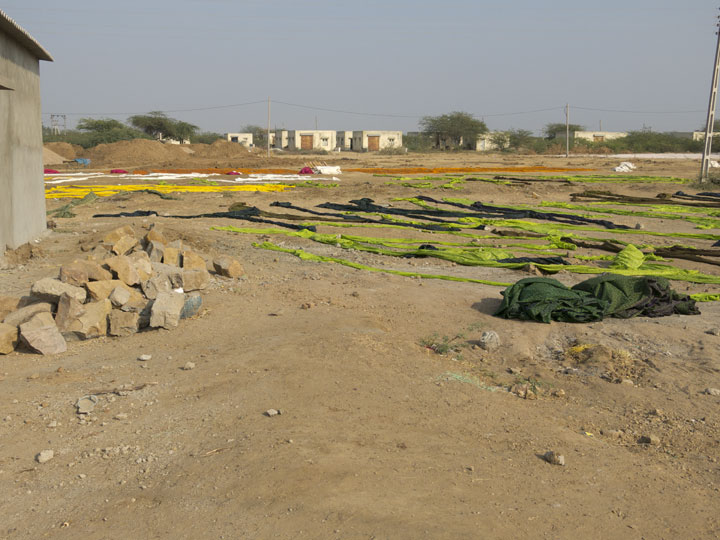Thursday, February 26, 2015
Mohmad Soyab A. Karim Khatri Fabric Designer
I was introduced to Mohmad through a lucky encounter with Judy Frater on a recent trip to Gujarat, India. Judy is an American textile expert, transplanted to India, where she is instrumental in supporting local artists through the Somaiya Gujarat Trust. Mohmad lives and works in the village of Bhuj, Kutch, with his family (sister, mother and father). Mohmad showed us his process, including designing original blocks (which are cut elsewhere), stamping fabric with natural dyes, often using a three-block process, and drying the fabrics outdoors. Much of the dye making process was familiar, having taken an art class with Chester Arnold, where we learned to make black ink from boiled rusty nails and oak gall. Mohmad explained his process in dye making, which includes making white with lime and gum; making black with iron water, sugar and the seed of some plant I couldn't identify; making red from mud and alum, etc. His whole family is involved in fabric making and the experience of touring his work space, understanding his process, and finally buying his beautiful hand made cotton and silk products was a thrill!
Labels:
Chester Arnold,
cotton,
fabric artist,
India,
Judy Frater,
Mohmad Khatri,
natural dye,
original design,
silk,
textile art
Thursday, February 12, 2015
Passion for Pashmina
The older one gets, the more pashminas are needed in one's wardrobe!
The best pashmina shawls come from India and are woven from fine goat wool. Hand-made pashmina products are finer, tighter, warmer and more luxurious than the machine made products. Generally machine made items can be identified by the unnaturally straight edge and fringe base. Good quality pashmina wool shawls are very light and very warm, with the highest quality being 100% pure pashmina wool (versus blends with silk). The “ring shawl” is a full-sized 100% pure pashmina shawl that theoretically is fine enough to pass through a ring. Pashminas are not the same as Shahtoosh, which is woven from endangered Tibetan Antelope wool, and which is illegal in most western countries. Pashmina shawls are often hand spun, woven and embroidered in Kashmir, such as the shawls on sale at Cottage Industries Exposition in Mumbai. Here one needs to haggle with Kashmir salesmen, who like to start their prices high and negotiate down. The lavender embroidered pashmina below is a Cottage Industries Exposition store's hand embroidered item. Alternatively, the very nice Calico Craft Center Shop in Ahmedabad has the wool shipped to their exclusive weavers and offers unique designs in their store at more reasonable prices. The pashmina below with the paisley design (two sided) was woven uniquely for Calico Craft.
The best pashmina shawls come from India and are woven from fine goat wool. Hand-made pashmina products are finer, tighter, warmer and more luxurious than the machine made products. Generally machine made items can be identified by the unnaturally straight edge and fringe base. Good quality pashmina wool shawls are very light and very warm, with the highest quality being 100% pure pashmina wool (versus blends with silk). The “ring shawl” is a full-sized 100% pure pashmina shawl that theoretically is fine enough to pass through a ring. Pashminas are not the same as Shahtoosh, which is woven from endangered Tibetan Antelope wool, and which is illegal in most western countries. Pashmina shawls are often hand spun, woven and embroidered in Kashmir, such as the shawls on sale at Cottage Industries Exposition in Mumbai. Here one needs to haggle with Kashmir salesmen, who like to start their prices high and negotiate down. The lavender embroidered pashmina below is a Cottage Industries Exposition store's hand embroidered item. Alternatively, the very nice Calico Craft Center Shop in Ahmedabad has the wool shipped to their exclusive weavers and offers unique designs in their store at more reasonable prices. The pashmina below with the paisley design (two sided) was woven uniquely for Calico Craft.
People often assume the paisley pattern (seen in the Ahmedabad pashmina) is from the British Isles. But this is false. From the excellent book Textile Arts of India,
published by Chronicle Books, the kalga, or paisley motif pattern, evolved from
17th-century floral designs created in tapestry-woven Mughal
textiles in India. By the late 18th
century the archetypal curved point had evolved. It was imitations of these patterns in shawls
woven in factories at Paisley, Scotland, that gave the design its name.
Some nice links:
Subscribe to:
Posts (Atom)




















